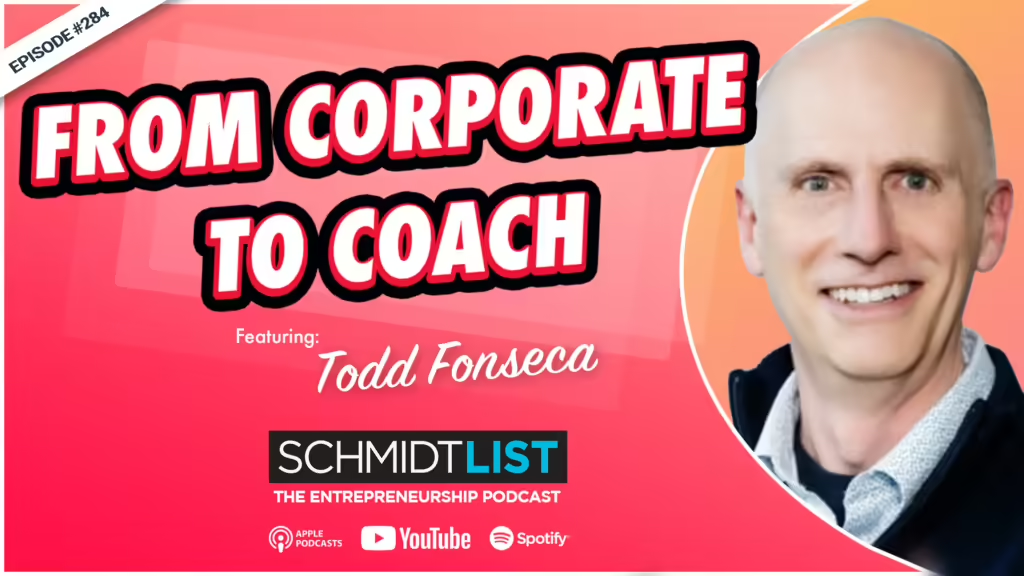Navigating Leadership, Change, and Personal Development with Todd Fonseca
Embracing Change in Leadership: Todd Fonseca’s Journey from Corporate to Coaching
In the latest episode of the Schmidt List podcast, host Kurt Schmidt welcomes Todd Fonseca to share his fascinating journey from corporate life to becoming a successful entrepreneur and leadership coach. This episode dives into key topics such as personal development, nonverbal communication, and effective change management, providing actionable insights for all leaders. Here’s a comprehensive look at the highlights:
From Corporate Executive to Entrepreneur
Todd Fonseca begins by detailing his transition from a successful corporate career to exploring the world of entrepreneurship. His motivation stemmed from a growing interest in leadership and personal development. This career shift wasn’t without its moments of introspection. One pivotal experience that led Fonseca down this new path was a corporate talent pipeline review where an employee was overlooked for promotion due to their appearance. This incident sparked his curiosity about nonverbal communication and body language, eventually leading him to become a certified body language trainer and later a certified hypnotist.
Mastering Nonverbal Communication
Fonseca’s exploration of nonverbal communication and body language led to valuable discoveries about the interplay between one’s inner narrative and outward presentation. By aligning these elements, Fonseca taught practical workshops within his company, gaining notable attention. This experience affirmed his coaching aspirations and highlighted the broader importance of self-awareness in leadership.
The Impact of Change on Organizational Dynamics
A major theme in the episode is the fear of change within organizations—a topic that’s highly relevant in today’s rapidly evolving business landscape. Fonseca and Schmidt explore the reasons why change scares many employees, particularly in light of economic uncertainties and the rise of AI technologies affecting job security. Fonseca introduces his Change Management Philosophy, which rests on three critical pillars: Psychological Safety, Capability, and Accountability.
The Three Pillars of Effective Change Management
Psychological Safety: Derived from Amy Edmondson’s concept, psychological safety involves creating an environment where employees do not fear sudden layoffs or drastic changes. This pillar is crucial for fostering openness and innovation within teams.
Capability: Ensuring employees have the necessary skills and resources to navigate change is vital. This includes continuous learning opportunities and support systems that help them adapt to new roles or technologies.
Accountability: While holding team members accountable is essential, overemphasizing accountability during change can exacerbate stress. Fonseca stresses balancing this pillar with the other two to maintain stability.
Nurturing Communication During Change
Kurt Schmidt emphasizes the importance of effective communication during organizational change. Transparency and clarity are vital when announcing changes, as employees naturally want to know how these changes will affect them personally. Recommendations include holding group and one-on-one sessions to discuss specific impacts with each employee.
Leadership Lessons: Vulnerability and Situational Adaptability
Another significant part of the discussion revolves around leadership. Schmidt shares his own experiences, emphasizing the importance of vulnerability and the challenge of balancing authority with approachability. Fonseca introduces the TAPS model (Tell, Ask, Problem, Solution) to help leaders adapt their approach based on different situations. Both agree that understanding team members’ underlying motivations is key to effective leadership.
Intentional Leadership and Open Discussions
Fonseca and Schmidt agree that intentionality and courage are essential in leadership discussions, especially during times of change. Leaders must be honest and open in their communications, ensuring employees feel heard and understood. This approach helps avoid unnecessary preparation for unlikely scenarios and leads to more efficient operations.
Managing Uncertainty with Structure
During uncertain times, such as organizational restructuring or the COVID-19 pandemic, Fonseca advises creating predictable touchpoints—like regular updates—to maintain stability. He encourages leaders to use the SCARF model to manage what they can, building relatedness even if they can’t provide complete certainty.
Conclusion: Personalized Leadership for Today’s Challenges
In conclusion, Todd Fonseca emphasizes that leadership should be personalized to fit the individual needs of team members rather than applying a one-size-fits-all approach. This personalization helps cater to different management preferences and leads to more effective leadership.
To stay updated with Todd Fonseca’s insights, follow him on LinkedIn and visit his website, thriving9to5.com. As Kurt Schmidt reflects on the value of these discussions, it’s clear that the fusion of personal development and innovative leadership practices can create resilient organizations ready to face today’s challenges.
